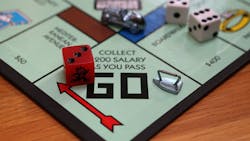In many ways, 2014 was a banner year for manufacturers. Rising production led to sustained growth and even hiring in some sectors. Can the rally continue? That's tougher to know, but we can be sure that next year will be different. Are you planning for changes?
It'd be easy not to. According to the latest data from the RBC Canadian Manufacturing Purchasing Managers’ Index, manufacturing activity held steady at 55.3 in November, the 20th consecutive month of growth. (A score of 50 or above signals growth.) In the U.S., The Institute of Supply Management’s index of manufacturing activity dipped slightly to 58.7 from 59.0 in the prior month. The mark is still just six-tenths of a percent below multiyear highs reached in August and March 2011. Nevertheless, history cautions against presuming that good times will persist.
Planning needn't be boring. Instead of holding daylong strategy sessions away from the factory, devise a game intended to boost performance in key areas. Sound crazy? It shouldn't. Gamification has become an increasingly common practice in organizations throughout the world. A Gartner study found that over 70% of Global 2000 organizations were planning on having at least one “gamified” application implemented for marketing or customer retention this year.
What's more, gamification may be the best way to design an engaging work environment. That's no small thing. According to Gallup, companies with highly engaged employees tend outperform those without by 202%. Ready to gamify some of your operations? Here are five principles for getting the most from your efforts:
1. Take stock. Do you know where your business is weak? At any given time, that may be the most important question you can ask as a factory operator but getting the answer might take more effort than you'd expect. Put in the time anyway. Resist assumptions and spend time talking with your floor workers. Find out which tools are working well and which aren't. Study patterns. Are certain hours of the day naturally unproductive? Is output always down during certain months? If so, why? When it comes to making operational changes, there's no substitute for good on-the-ground intelligence.
2. Limit your focus. Games have rules and limits. Embrace this idea for your own gamifying efforts. After all, you don't have to fix everything at once. Say the line tends to underperform in the first quarter. Design a game whereby each shift acts as a team in a race to boost output. Document everything and then dole out rewards for the winners at the end of the contest. But don't stop there. Also take stock of how well each team is playing and make note of outstanding daily, weekly, and monthly outcomes. Celebrate the process as you aim for better results.
Motivation, Simplicity & Rewards
3. Know what motivates your employees. Defining the game isn't enough. What if your workers don't want to play? Make sure that your gamification efforts resonate with the people you most need to engage. Start by conducting a survey to find out what is most meaningful to your workers. Are there specific types of rewards they seek? What are the fixable annoyances plaguing their workday? Also, walk the floor! Observe problems up close and talk with someone you haven't met to get a fresh perspective on operations. Chances are, you'll come away with an idea for a game worth playing.
4. Make easy rules. Think about the world's best-selling board games. Checkers has a handful of moves. Chess doesn't have many more. Monopoly is about acquiring property. Top-selling games do well because they're accessible. The rulebook isn't long, and playing doesn't take too much time. They don't limit the pool of potential players. So it should be with your own gamification efforts. Define just two of three objectives you want to achieve as a company and then assign rewards as bounties. The first team to accomplish a goal gets the bounty. Rinse and repeat until all bounties are claimed.
5. Give generously when the results merit it. You've developed the game and defined the rules. Now, it's time to break them by giving extra rewards and recognition for truly outstanding performance. Why? Shackling yourself to the rules of the game doesn't make sense when your secret hope -- always -- is for exceptional outcomes that blow away your intended targets. Adding spot rewards to account for these outliers should preserve your gamification efforts while encouraging the best possible work everyday.
Finally, remember that gamification is just one tool for encouraging high performance. The key to ongoing success -- in good markets and bad -- is to continuously seek out and recognize great work wherever it’s occurring.
John Mills is executive vice president of Business Development at Rideau Recognition Solutions, a global leader in employee rewards and recognition programs designed to motivate and increase engagement and productivity across the workforce.
About the Author
John Mills
Executive Vice President of Business Development
John Mills is executive vice president of Business Development at Rideau Recognition Solutions, a global leader in employee rewards and recognition programs designed to motivate and increase engagement and productivity across the workforce.
